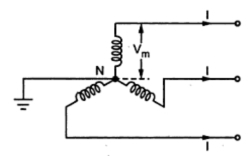The selection of a particular type of a.c. or d.c. system for the transmission and distribution is based on comparison of amount of material i.e. copper necessary for the various systems. As mentioned earlier, the maximum stress in the overhead system exists between the conductor and earth. Hence comparison of material required is done assuming the maximum voltage between any conductor and earth being the same. The assumptions made for the comparison are :
1. The power (P) transmitted by all the systems is same.
2. The distance ( l ) over which the power is transmitted is same.
3. The power loss (W) in all the systems are same.
4. The maximum voltage (Vm) exists between any conductor and the earth, in all the systems.
1.1 Two Wire D.C. System With One Line Earthed
Where P = Power transmitted
The volume of copper required for other systems is compared by taking volume of copper required for this system as base. Let it be constant K and volume of copper required for other systems can be expressed interms of K.
1.2 Two Wire D.C. System With Midpoint Earthed
Thus the volume of copper required in this system is one fourth the volume of copper required for two wire d.c. system with one line earthed.
1.3 Three Wire D.C. System
Let A = Cross-section of outer conductors
Let area of cross-section of the middle neutral wire is half of the area of cross-section of the outer conductor.
Hence the total volume of copper
Thus the volume of copper required in this system is 0.3125 times the volume of copper required for two wire d.c. system with one line earthed.
1.4 Three Phase Three Wire A.C. System
The maximum voltage between each line conductor and the neutral is Vm as shown in the Fig. 4.
Thus the volume of copper required depends on power factor of the load and it is 0.5/cos2Φ times the volume of copper required by twp wire d.c. system with one line earthed. This system may be delta connected but irrespective of the method of connection star or delta, the result derived remains same.
1.5 Three Phase Four Wire A.C. System
This system is popularly used for secondary distribution. The neutral is also made available for the connection of the load. The system is shown in the Fig. 4.
Assuming the load balanced, there is no current flowing through the neutral.
The cross-section area of neutral is half the cross-section of each conductor i.e. 0.5 A where A is cross-section of each conductor.
Hence all the calculations upto the copper losses and expression of A remain same as derived for three phase three wire system.
The total volume of copper requires is,
= Volume of copper for 3 lines + copper required for neutral
= Volume of copper for 3 lines + copper required for neutral
Thus the volume of copper required is 0.583/cos2Φ times the volume of copper required by two wire d.c. system with one line earthed.


























No comments:
Post a Comment